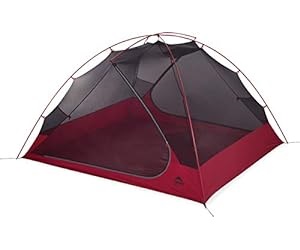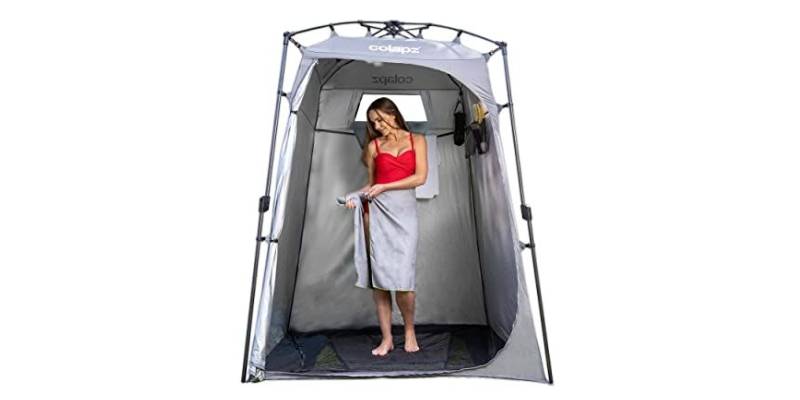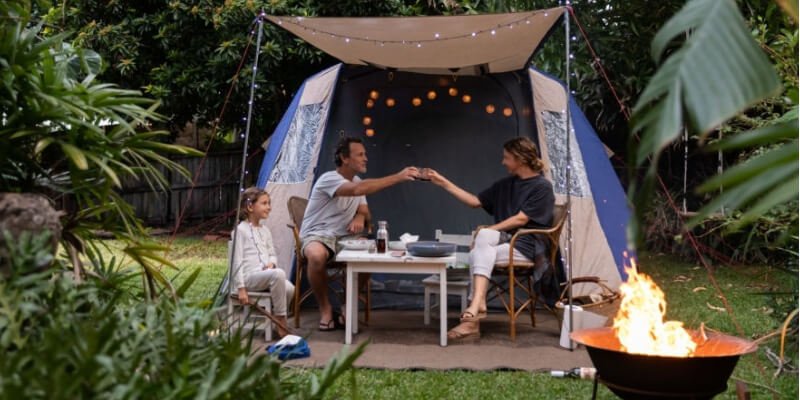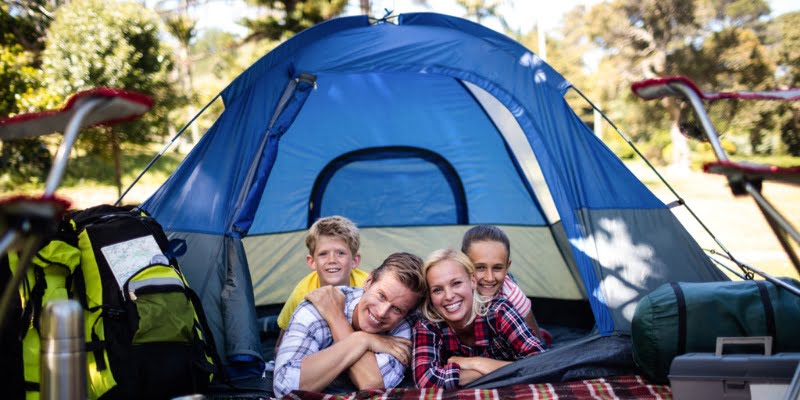Best Backpacking Tents of 2025
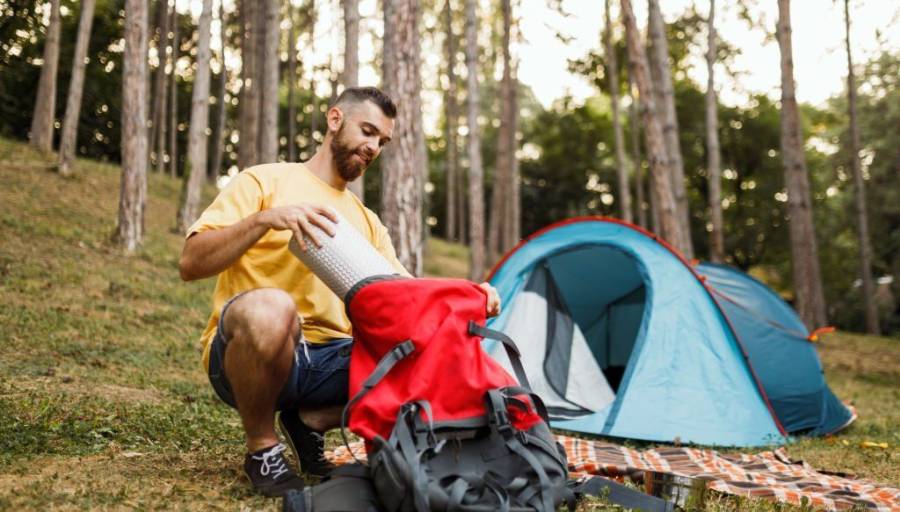
Gone are the days of bulky, heavy tents hindering your exploration. Modern backpacking tents offer a perfect blend of lightweight portability, weather protection, and comfortable livability.
Whether you’re a family of backpackers, a mountaineer, or simply a fan of outdoor adventures, you’ll find the best backpacking tent here to shelter you in case of unfavorable weather conditions. It’s not just about keeping you dry; it’s about providing peace of mind, even in the harshest environments.
These top-quality tents have undergone thorough examination by our team. We’ve tested them in the harshest rain, fiercest winds, and coldest nights. We also provide a dedicated buying guide so you can choose a backpacking tent that suits your needs with complete peace of mind!
Best Backpacking Tents Reviews of 2025
Take a close look at our ranking of the top 10 best backpacking tents in 2025…
- MSR Hubba Hubba Nx Tent – Best Backpacking Tent of all Categories
- MSR Zoic 3 Tent – Lightweight and Breathable for Family or Friends
- Ferrino Sling 1 Person Tent – Excellent Value for the Money
- Camp Minima 2 Pro – Compact and Light, and built with Double Roof
- MSR Elixir 3 – Extremely Livable Tent At an Affordable Price
- Vaude Campo XT 2P – Spacious and Comfortable Backpacking Tent
- MSR Habit 4 – Excellent Protection Against Tough Storms & Weather
- Camp Tent Minima 1 SL – Best Backpacking Tunnel Tent
- Ferrino Proxes 4 – Good Ventilation, Resistance and Habitability
- Vaude Taurus 2P – Reasonable Space for Couple or Two people
1. MSR Hubba Hubba NX 2
Specifications:
- Number of people: 2
- Seasonality: 3
- Weight: 1,720 g
- Room dimensions: 213 x 127 x 100 cm
- Materials and coverings: 20 denier x 330T ripstop nylon flysheet; Durashield silicone and polyurethane coating; 30 denier x 262 T ripstop nylon floor with Durashield silicone and polyurethane coating
- Water column and waterproofing in mm: 3000 mm floor / 1200 mm roof
- Apses: Yes, two
The MSR Hubba Nx costs more than all of our other picks, but it’s an option we encourage you to consider seriously, if you’re looking for a durable two-person backpacking tent that combines unrivaled roominess with generous space. Considering the build quality and features, it’s a smart investment that you won’t regret.
Although this is not the lightest or roomiest tent 2-person tent on the market, this premium backpacking tent positively ticks almost all the boxes, thanks to an Optimized Symmetrical Geometry design that has been studied to offer enough comfort.
It has enough space to accommodate sleeping systems for two people and store other essentials for backpacking trips. Whether you want to relax sitting or kneeling, it will allow you to feel perfectly at ease where others may seem cramped and claustrophobic for two.
Unlike many ultralight tents, it features two doors and vestibules as well as nearly vertical walls, which ensure excellent habitability. Added to this, there are adjustable integrated installation loops that speed up installation.
The MSR Hubba Hubba Nx is very well-built and ready to follow you for adventures in 3 seasons. It has a solid bed that can withstand rough use. For this reason, it performs very well in wet and windy conditions. Its weather resistance is excellent, and its pole-to-hub design guarantees rock-solid stability.
Other good things about the MSR Hubba Hubba Nx: it has superior ventilation to suit summer hiking and includes full coverage to effectively protect occupants in rain showers. The easily movable and tilting freestanding structure for perfect positioning, the twin D-shaped doors (each with a large porch) give each occupant their own entrance and space to store a backpack and boots….
Pros
- Excellent weather resistance
- Premium materials and quality construction
- Spacious and comfortable interior
- Complete set up for backpacking
Cons
- Expensive, but the price is justified
2. MSR Zoic 3 Tent Ultralight
Specifications:
- Number of people: 3
- Seasonality: 3
- Weight: 2,670 g
- Room dimensions: 223 x 191 x 100 cm
- Materials and coverings: flysheet in 40 denier Ripstop polyester coated with Xtreme Shield polyurethane and silicone; Floor in 70 denier Ripstop nylon, Xtreme Shield polyurethane coating and hydrophobic protection.
- Water Column and waterproofing in mm: 3,000 mm on the ground / 1,500 mm on the roof
- Apses: yes, 2
If you are looking for a high-quality backpacking tent from MSR, but cannot afford some of their high-end tents, then the MSR Zoic 3 is an option worth considering. It is designed to accommodate up to three people, making it ideal for traveling with family or friends.
This backpacking tent is equipped with three geared lofts for custom storage options and has two easy-access doors that make it easy to get in and out in the middle of the night when needed. The Zoic 3 comes with durable and lightweight aluminum poles (proven MSR design geometry) with a long-lasting Xtreme Shield waterproof coating…
This ultralight tent offers decent storm protection and can count on its 1500mm waterproof rating rain fly that covers the whole body from top to bottom. That said, one of the main draws of the MSR Zoic 3 is its excellent performance in terms of ventilation and airflow.
The ultra-breathable canopy is made from micro-mesh panels. For hot weather adventures, you can count on a cool and dry interior. To ensure maximum breathability, the Zoic 3 tent also benefits from optimal moisture control and offers beautiful views from the inside, as it is composed of very little fabric obstructing the view.
While the wide floor plan and steep sidewalls create a spacious interior, this tent is slightly smaller than most 3-person models, so it might be a little tight for you and two other campers.
To install this tent, you will not have to break your head because it has a self-supporting structure that can support its own weight on any terrain and does not even need to be staked in most cases.
Pros
- Excellent ventilation and airflow performance
- Durable and water-resistant floor
- Affordable price for the level of quality
- Effective protection against heavy downpours
Cons
- Smaller than most 3-person models
3. Ferrino Sling 1 Person Tent
Specifications:
- Number of people: 1
- Seasonality: 3
- Weight: 1,250 g
- Bedroom dimensions: 220 x 80 x 65 cm
- Materials and coverings: double roof in 70 D diamond polyester, 75 g/m² and thermally insulating polyurethane floor
- Water column and impermeability in mm: 2,500 mm on the ground / 2,000 mm on the roof
- Apses: no
If you’re on a tight budget and need a good one-person backpacking tent, look no further than the Ferrino Sling 1. It offers all basic features and has everything that you need for your solo adventures. It is lightweight (just 1250g) and compact. You can set up easily and provide you with adequate shelter in mild climates.
The package comes with aluminum anchor pins, a carry bag, and a repair kit. This backpacking tent measures just 32cm long and 12cm wide when folded. However, this compact design does not prevent it from offering a spacious interior to make you feel comfortable.
The Ferrino Sling 1 has a chamber that is 220 cm long and 80 cm wide at the shoulders. As for the transport dimensions, they are only 33 x 12 cm, which takes up almost no space in your backpack.
Other advantages of the Sling 1 that are worth mentioning: it has interior pockets where you can store your personal items. Similarly, a hook is provided so that you can hang a lamp. It is waterproof and able to withstand the most adverse weather conditions. It is therefore equipped with a water column of 2000 mm.
However, the tent doesn’t really have an apse. The space at the entrance is enough for shoes or small gear, but not for a backpack. It is large enough to have a 40L bag next to you. If a backpack is large, take a suitable trash bag in which to leave it outside.
Pros
- Excellent build quality
- Thermal-insulating Coating
- Small footprint and easy transport
- Quick and easy assembly
Cons
- May be too narrow for some large person
4. Camp Minima 2 Pro
Specifications:
- Number of people: 2
- Seasonality: 3
- Weight: 2,100 g
- Bedroom dimensions: 220 x 120 x 100 cm
- Materials and coverings: flysheet in 30D Ripstop nylon, and floor in 70 D 190T/N nylon polyamide
- Water column and waterproofing in mm: 5,000 mm on the ground / 3,000 mm on the roof
- Apses: yes, two
If you’re looking for a compact and lightweight 3-season backpacking tent, the Camp Minima 2 Pro might be just what you need to fully enjoy your next hiking or camping adventure. Although it is very light and intended to accommodate two people, it demonstrates great stability and relies on its double-walled design to guarantee effective protection against the elements.
The package includes a compression carrying bag, pegs, additional guy lines and a repair kit. This tent is also appreciated for its manufacturing quality, which guarantees durability despite the apparent fragility of its construction materials (flysheet in 30D Ripstop nylon and platform in 70 D 190T/N nylon polyamide). So you don’t have to fear unpleasant surprises when you venture into difficult conditions.
The Camp Minima 2 Pro also promises to keep you dry, thanks to its light, strong, and completely waterproof rain fly. Likewise, it has a waterproof index of 5,000 mm for the floor and 2,000 mm for the roof. That being said, if we recommend this 3-season tent, it’s also for the good climate that reigns within it.
It features an all-mesh main frame and a rainfly with two large windows and cross-vents for this purpose. This allows a sufficient amount of air to enter, as well as effective moisture management.
Another interesting feature: the bedroom has dimensions of 220 x 120 x 100 cm, which is enough for two people to sleep there. You and your partner will be able to enter the tent at the same time as it has two large zipped entrances (one on each side).
Let’s finish by noting that the Camp Minima 2 Pro offers plenty of storage options, with its four pockets on each side and its two large vestibules that provide the extra space needed to curl up in bad weather.
Pros
- Large vestibules on both sides for extra capacity
- Very good ventilation
- Quick and easy installation
- Two large zipped entrances
- Pockets and lamp holder
Cons
- Nothing to say
5. MSR Elixir 3 Livable
Specifications:
- Number of people: 3
- Seasonality: 3
- Weight: 3,190 g
- Room dimensions: 213 x 172 x 104 cm
- Materials and coatings: flysheet in 68 denier Ripstop polyester with polyurethane coating and DWR coating; floor in 70 denier nylon taffeta, polyurethane coating and DWR coating
- Water column and impermeability in mm: 3000 mm on the ground / 1500 mm on the roof
- Apses: yes; 2
Although it weighs a little more than other 3-person tents in its class, the MSR Elixir 3 is a great backpacking tent in almost every way we have considered. With the perfect combination of comfort, lightweight, quality and affordability, it is ideal for most camping or hiking situations.
It is very easy to set up in about a minute or two. All of its poles are strong enough not to come undone. As long as you pitch the tent correctly, you’re guaranteed to end up with stable shelter, even in a windstorm.
The MSR Elixir 3 is certainly not made to withstand extreme cold weather or snow, but for a 3-season tent, it handles rain, wind, and chilly nights surprisingly well. Even this tent is well-armed to handle different adverse weather conditions without failure.
This tent further manages to offer excellent ventilation without compromising privacy or warmth. So you won’t have to fear on hot days, as the Elixir 3’s micro-mesh canopy guarantees maximum breathability.
We also recommend this tent because it is extremely livable. It adopts a unique geometry of the poles which optimizes the headroom. This design offers plenty of headroom and is roomy enough (especially for two people with their gear) and comfortable. However, the floor space may be too small for three tall people to sleep comfortably inside.
One thing we like about the Elixir 3 is that it offers excellent outside views, thanks to its adaptable rain fly. Other features like built-in lofts and glow-in-the-dark zipper pull enhance livability. It also features two large doors for easy entry as well as two large vestibules for storing your muddy or wet boots and clothes.
Pros
- Effective protection against adverse weather conditions
- Good ventilation without compromising warmth and privacy
- Excellent value
- Very good habitability
- Easy setup
Cons
- Not the lightest or most compact option
6. Vaude Campo Compact XT 2P
Specifications:
- Number of people: 2
- Seasonality: 3
- Weight: 2,700 g
- Room dimensions: 215 x 140 x 105 cm
- Materials and coverings: 100% polyester 75 denier polyurethane flysheet; 100% 70 denier polyamide coated polyurethane floor.
- Water column and impermeability in mm: 5,000 mm on the ground / 3,000 mm on the roof
- Apses: yes, 1
Vaude Campo XT 2P backpacking tent is built with a versatile structure, making it suitable for both camping and trekking. It has been designed to allow occupants to sleep and live in comfort. Vaude overlooked no detail. To give an example, the outer layer of the tent has been darkened for greater sleeping comfort while the inner material is lightweight to make living inside easier.
The 215 x 140 x 105 cm bedroom offers enough space for two without the tent having too large a footprint. Likewise, the Vaude Campo XT 2P demonstrates great stability in strong winds, thanks in large part to its solid aluminum frame that withstands many assemblies and disassemblies cycles.
When it comes to deployment, it’s not the fastest-to-assemble model we’ve encountered. It usually takes about fifteen minutes. This somewhat long time is not because the assembly is difficult. There is also a multitude of connectors, which can be a bit confusing and make assembly tedious. Fortunately, the hoops or hoops elements, as well as the tubes are marked with a color code that guides the orientation of the poles.
However, this tent stands out positively and protects against bad weather greatly. And with a water column of 3000mm and a waterproof rating of 5000mm for the floor material, you are sure to have a dry refuge even with the heaviest downpour of rain.
Vaude has also done a nice job with ventilation and humidity management. For this, the inner tent is made of 68 D polyester with excellent properties to prevent condensation. And the walls like the door (of the inner tent) have ventilation inserts in anti-mosquito mesh to let in a quantity of air.
Note that the Campo XT 2P has a wide entrance, which also contributes to a good climate within the shelter. This 3-season tent has pockets inside for storing various objects. Above all, it is a spacious canopy that offers enough room to store equipment or cook in case of bad weather.
Pros
- Excellent value
- The canopy is big enough for meal prep
- High wind resistance
- Compact folding design
Cons
- The assembly process is a bit tedious
7. MSR Habit 4
Specifications:
- Number of people: 4
- Seasonality: 3
- Weight: 5720 g
- Bedroom dimensions: 241 x 241 x 185 cm
- Materials and coverings: Flysheet in 68 denier polyurethane-coated Ripstop polyester; Parterre in 68 denier polyester taffeta with polyurethane coating.
- Water column and impermeability in mm: 10,000 mm on the ground / 1,500 mm on the roof
- Apses: yes, 1
Even though the MSR Habit 4 sacrifices ventilation somewhat, it is one of the best backpacking tents you will find in terms of durability and weather protection. The tent is designed to withstand rough and intensive use, so don’t have to worry about harsh campsites or bad weather.
Its sturdy construction, made from lightweight and high-quality materials, is joined by one of the best post systems we have seen. So this dome tent can support its weight on any terrain without having to be staked in most cases. However, in strong winds, it is always better to secure it to the ground with the Steel stakes and guy lines included. Once in place, the MSR Habit 4 provides safe and comfortable shelter, even in harsh conditions.
It’s durable and has a water-resistant floor. It also has a rainfly that completely covers its body from top to bottom. The robust construction and full-length rain fly ensure good resistance in case of strong winds.
This model has a waterproof rating of 1,500 mm, so you will be effectively protected in the event of heavy showers. Likewise, the MSR Habit 4 includes a vestibule that provides enough space for storing shoes and other belongings.
One of the main features of the MSR Habit 4 is that it can accommodate up to four people. However, we find this tent works best with two adults and two children. Besides this, the high height (about 12% more headroom compared to similarly sized tents) offers plenty of headroom.
All in all, the MSR Habit 4 may be a little more expensive than most four-person tents, but on closer analysis, it’s a worthwhile investment. It will serve you for many years. It also offers solid performance even in difficult conditions with very good habitability compared to most other cabin-style family tents.
Pros
- Large and spacious enough for two adults and two children
- Integrated vestibule with full coverage rain fly
- Excellent aluminum pole structure
- Many pockets of different sizes
Cons
- Ventilation can do better
8. Camp Tent Minima 1 SL
Specifications:
- Number of people: 1
- Seasonality: 3
- Weight: 1,150 g
- Bedroom dimensions: 220 x 80 x 65 cm
- Materials and coverings: 30D Ripstop nylon flysheet and 70 D nylon polyamide floor.
- Water column and waterproofness in mm: 5,000 mm on the ground / 2,000 mm on the roof
- Apses: NC
Weighing just 1150g, including frame and poles, the Camp Minima 1 SL is the lightest tent in our top 10 list. Its small size allows it to be easily transported in the supplied bag or in another if you already have. This tent is made up of small diameter poles, a 30 D Ripstop nylon flysheet, and a 70 D nylon polyamide bed.
Camp Minima 1 SL backpacking tent is made of fairly solid materials that provide good resistance, which is a big advantage given its size. However, you must ensure that you configure it correctly. Another thing we like about this one-person tent is that it can withstand a lot of weather conditions.
Fortunately, assembling the Camp Minima 1 SL is not at all difficult and won’t take you more than 10 minutes if the ground does not present any particular constraints. The aluminum stakes and guy wires provided for assembly are easily identifiable. Additionally, it features a porch light (requires 2 CR2032 batteries, not included) to facilitate easy entry during nighttime.
Besides a waterproof index of 2,000 mm for the outer canvas and 5,000 mm for the ground that exceeds the characteristics usually found on ultralight tents, the Camp Minima 1 SL has a structure mesh fabric for optimal ventilation. As for its outer fabric, it guarantees good heat distribution.
Pros
- Surprisingly stable considering the lightweight
- Compact and super lightweight design
- Quick assembly and disassembly
- Very small packing volume
Cons
- Average ventilation when the front vestibule is closed
9. Ferrino Proxes 4
Specifications:
- Number of people: 4
- Seasonality: 3
- Weight: 9,000 g
- Room dimensions: 210 x 240 x 170 cm
- Materials and coverings: flysheet in Diamond 70D polyester, 75 g/m2, aluminized heat-insulating polyurethane coating; floor in 70D polyester, 80 g/m2
- Water column and impermeability in mm: 2,000 mm on the ground / 2,500 mm on the roof
- Apses: yes, 1
The Ferrino Proxes 4 is not the features rich 4-person tent on the market but is great value for money. Its large structure, spacious bedrooms & living area, and above all affordable price make it an option that deserves serious consideration.
It has a tunnel shape and is designed with three fiberglass poles with drawstrings. The Ferrino Proxes 4 offers a perfect combination of ventilation, resistance, and habitability. Even though the solid construction of this tent implies a rather heavy weight of 9 kg, you are assured of having a safe shelter that effectively protects you and your fellow camper in all weather conditions during 3 seasons of use.
The Ferrino Proxes 4 is also appreciated for its ability to provide good ventilation, which makes it suitable for camping in hot weather. The “Air” system with a large mosquito net, sleeves, and ventilation windows, which joins the water-repellent polyester interior, promotes good maximum breathability. With this in mind, the rather closed structure makes it work best in a cool climate.
As mentioned above, one of the biggest attractions of the Ferrino Proxes 4 is that it offers generous space. Ferrino states a capacity of up to four people. The dimensions of room 210 x 240 x 170 cm mean that four medium to large adults won’t feel cramped.
On the other hand, this tent is perfect for three big adults or a family camping with two adults, children, and all their equipment. Let’s finish…you won’t have any trouble installing it as long as you follow the instructions provided by the manufacturer. A video is available for configuration with the activation of the tent’s QR code.
Pros
- Good balance of ventilation, resistance and habitability
- Spacious bedrooms and living area
- Large Vestibule
- Very good value for the money
Cons
- Heavyweight
10. Vaude Taurus 2P
Specifications:
- Number of people: 2
- Seasonality: 3
- Weight: 2,600 g
- Room dimensions: 230 x 130 x 95 cm
- Materials and coverings: 100% polyester 75 denier polyurethane flysheet; floor 100% 70 denier polyamide, polyurethane coated
- Water column and impermeability in mm: 5,000 mm on the ground / 3,000 mm on the roof
- Apses: yes, 1
We present the final entry in our list of the top ten best backpacking tents. With its 2.6 kg on the scale, the Vaude Taurus 2P is not the lightest two-person tent, but its relatively heavy weight is a fair compromise to benefit from typical German quality. It is perfect for camping & hiking and inspires confidence with its construction. It is able to perform well even in inclement weather conditions.
With a canopy dome structure, it is made from polyester, which offers a good compromise between lightness and resistance. This three-season tent includes a flysheet made from 75 denier polyurethane polyester and a floor entirely in coated 70 denier polyamide polyurethane. So you can use it for camping on small rocks and twigs without problems.
Also, the interior of Vaude Taurus 2P provides enough space (230 x 130 x 95 cm) for two people to sleep. On the other hand, the walls of this tent are low and inclined, and the space is narrow for two people to sit at a time. Thus, it is not particularly pleasant to shelter in this tent while waiting for a storm to calm down.
However, the Vaude Taurus 2P stands out positively when it comes to weather protection, thanks to its double-walled design and rain fly. The ventilation inside the tent is also very good. This is made possible by the design of its interior walls in polyester and by the clever ventilation system with openings in the roof. Likewise, the vestibule has four zippers through which you can open it from either side or from the top to increase the incoming airflow.
Pros
- Clever ventilation system with openings in the roof
- Sturdy and durable construction
- Easy to assemble
- Small footprint, but enough space to sleep two.
Cons
- Slightly short pegs
Best Backpacking Tent Buying Guide
You’re already aware that not all models are equal in terms of performance and suitability for different activities. This guide will unveil the key factors to consider for making a wise investment in a backpacking tent.
Choose a tent according to your use
Depending on your uses (static or roaming), the choice is decisive for a good night’s sleep outdoors. Here are the different situations that may lead you to choose one model over another:
- Camping: in this situation where you will probably spend several days in the same place, a comfortable, spacious tent is preferable. Here, the weight is not a problem. Theoretically, you can bring your camping equipment by motorized vehicle.
- Hiking: if you plan to go hiking or constantly roam, it is necessary to favor a light and practical tent model, suitable for several seasons.
- Ultra-light hiking: For this purpose, ultra-light tents crafted with innovative materials and typically designed for one person are ideal.
- Expedition in the high mountains: For high mountain expeditions where facing harsh elements and challenging climatic conditions is common, it’s essential to choose four-season tents.
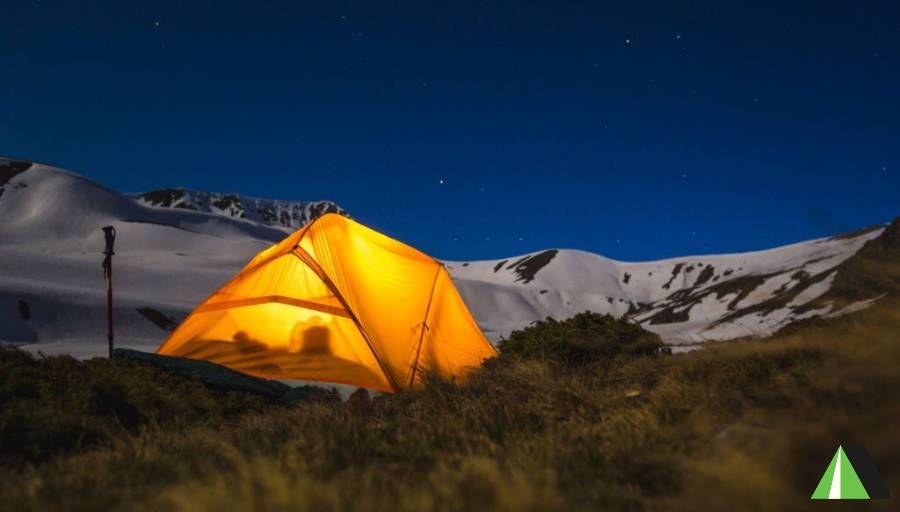
Seasonality
Seasonality is a crucial factor when choosing a tent, as it determines the tent’s insulation capacity and overall durability:
- 2 seasons: These tents are typically suitable for spring and summer use. They perform well in mild weather conditions.
- 3 seasons: These tents are usable from spring to autumn and sometimes into mild winters. However, they may not withstand extremely harsh winter conditions like heavy snowfall and blizzards.
- 4 seasons: These tents are designed for year-round use in any destination. They provide optimal protection against all elements and weather while featuring a sturdy design.
The different forms of tents
There are three types of backpacking tent shapes on the market:
- Dome tent (also known as an igloo tent): This is a popular model known for its ease of setup and self-supporting design using two intersecting poles at the top for stability. Geodesic tents are a variation of dome tents but have additional poles for increased strength.
- Tunnel tents: These tents are spacious and suitable for multiple occupants or storing equipment because of their surface area. They require full guying for support as they are non-self-supporting. Tunnel tents feature a structure made of semi-circular arches that form the tunnel shape.
- Tipi tents: Shaped like a pyramidal structure, tipi tents can sometimes be compartmentalized for practicality and socializing. Some models are compatible with wood stoves for added comfort during camping trips.
Self-supporting
- Self-supporting tents: these tents stand upright without the need to use pegs, but the absence of the use of pegs will allow them to be installed on all types of ground even the most difficult such as sand. They require little floor space and are very versatile. You can buy these tents to guarantee increased safety and stability in the wind.
- Non-self-supporting tents: these tents do not stand up without fixing and guying with sardines. What could be likened to a disadvantage: nothing could be simpler than installing a non-self-supporting tent. On the other hand, its installation will require a ground compatible with sardines.
- Semi-freestanding tents: these tents stand up almost on their own but require one or two pegs to optimize their volume.
The type of roof
There are two types of roofs for tents:
- Single-wall: these tents do not have the “inner room and double-roof” combination, but only have a simple single-wall roof. The main advantage of these tents is their incredible lightness and small size. On the other hand, they are sensitive to the formation of condensation inside and do not offer good evaporation of humidity.
- Double-walled: these tents have an inner chamber and a double roof, allowing them to optimize protection against the elements: wind, rain, and humidity. The outer canvas is generally made of water-repellent material.
The capacity
The capacity of a tent refers to the number of people it can shelter, impacting its weight and required installation area. This capacity is determined by the tent’s dimensions, including width, length, and ceiling height to accommodate hiking mattresses and sitting space.
Tents with vertical interior walls offer more roominess than those with angled walls. Furthermore, an apse is beneficial for storing hiking gear and preparing meals during rainy conditions.
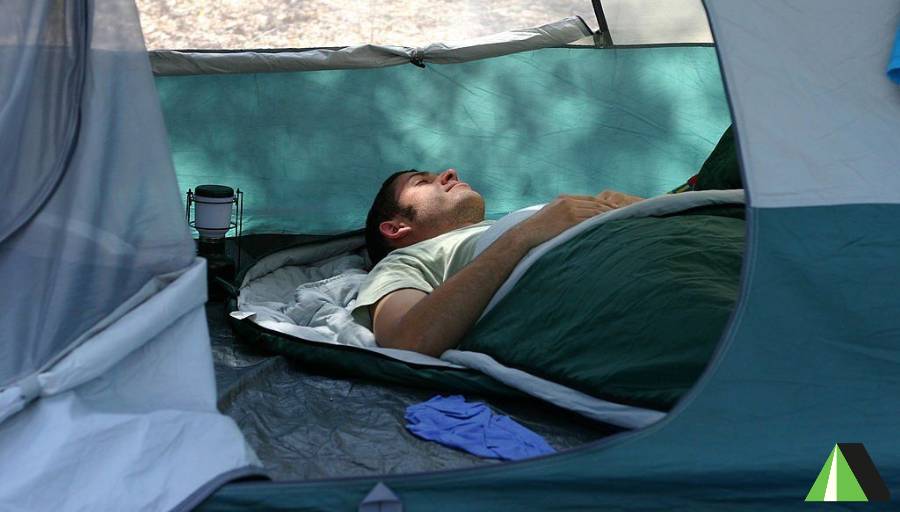
Comfort
The comfort of a tent is determined by the capacity of the tent and its layout. The number of doors and openings should also be considered. Because the more doors you have, the easier it will be to move around if there are many of you sheltering in the tent. Several openings will also allow good ventilation.
The materials
Choosing the right materials for a tent is crucial for durability, waterproofing, protection against insects, and UV rays. Here are some considerations regarding tent fabric and weaving process:
- Nylon (Polyamide): A flexible, lightweight, and strong synthetic fabric. It’s prone to UV damage and can expand when wet, so it’s often treated for UV resistance and waterproofing on the outer surface.
- Polyester: Another synthetic fabric that is heavier and less elastic compared to nylon. It doesn’t absorb water and maintains its shape well but may not be as durable as nylon in the long run.
Regarding the weaving process:
- Ripstop: This weaving technique, used for both nylon and polyester, enhances resistance against tearing and abrasion, making the tent fabric more durable.
- Taffeta: Another weaving process applied to nylon and polyester fabrics, providing excellent durability, quick drying, waterproofing, and wind resistance.
The deniers
The deniers are a specification that can be found in the descriptions of the products. It will give a good indication of their robustness. For example, if the expressed deniers are 150D, it means that the fabric used is a yarn of fabrics with a weight of 150g for a length of 9000 meters of yarn. The higher the number, the more robust but also heavier the fabric will be.
Coatings and treatments
Coatings and surface treatments play a crucial role in ensuring the durability, waterproofing, and UV resistance of a tent:
- Polyurethane (PU) Coating: This coating, applied in layers on the fabric, provides waterproofing values ranging from 800mm to 10,000mm in water columns. However, thicker PU layers make the fabric more waterproof but also heavier.
- Thermoplastic Polyurethane Coating (TPU): TPU coating offers enhanced wear resistance compared to traditional PU coating, making it more durable over time.
- Silicone Coating: Generally found on nylon tents, silicone coating increases tear and UV resistance while also preserving the colors of the tent for a longer period, thus extending its lifespan.
High-end tents use a silicone coating on both sides of their walls. However, silicone and PU coatings degrade over time and successive uses (folding, unfolding, handling, etc.). It is highly recommended to choose tents with a high water column index.
The seams
The seams are often the weak point of tents because they can come loose and/or facilitate water infiltration. To make sewing threads waterproof, manufacturers use two methods:
- Silicone treatment on the seams (for nylon fabrics).
- Heat-sealed or heat-sealed strips on the seams (for polyester fabrics).
The poles
The materials used in the construction of tent poles are crucial considerations:
- Fiberglass: Typically used in entry-level tents, fiberglass poles can be heavy and prone to fragility.
- Aluminum: Offers an excellent weight-to-strength ratio. Aluminum poles are durable and flexible, reducing the risk of breakage under tension. Some aluminum poles are designed with alloys for enhanced properties.
- Carbon: Known for its exceptional strength-to-weight ratio, carbon poles provide excellent rigidity and durability.
- Composite Fibers: Light and strong, composite fiber poles are more flexible than aluminum or carbon, contributing to the overall durability of the tent.
The diameter of a pole will also influence the sturdiness of a tent.
Sardines/Pegs
Finally, sardines can also be made of several materials:
- Stainless steel will guarantee good solidity at the expense of high weight.
- The aluminum will make them light.
- Titanium will be even lighter but much more expensive.
- ABS plastic will be strong and inexpensive.
- The fabric will be suitable for soft ground etc.
Pegs are also available in different shapes for different uses but an essential factor as they can be purchased separately.
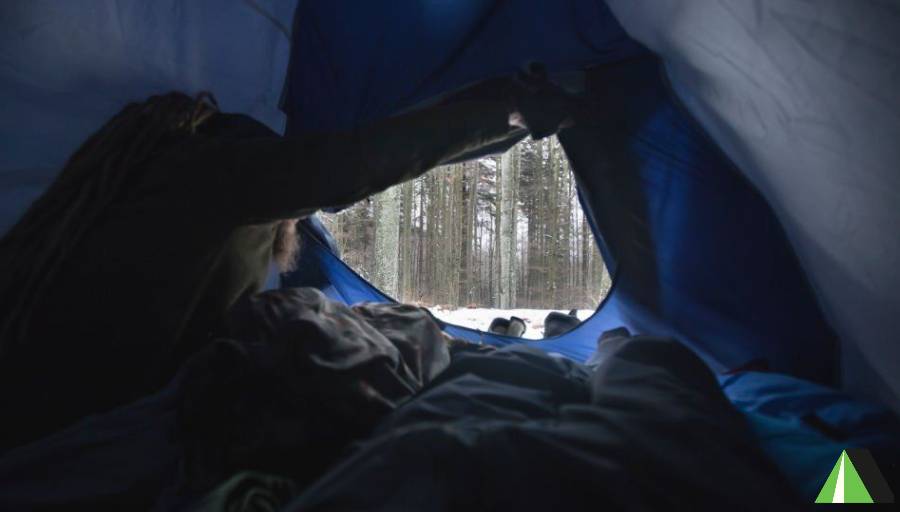
The colors
This point may seem secondary but it is important. If you are hiking in winter or in environments with little sunlight, choose a clear backpacking tent that will allow you to benefit from more light inside the tent. On the other hand, a colored tent guarantees safety and allows you to be visible if you get lost.
The price
Depending on the type of tent, capacity, and the materials used in its design, the price varies from model to model. For entry-level small backpacking tents, you can find tents for around $150 while the most elaborate and top-of-the-range models can come close to $1000 or more.
FAQs
How do I choose the right size of a backpacking tent?
Selecting the right size tent depends on the number of occupants, and the level of comfort desired. Consider opting for a tent that accommodates one more person than you intend to house. This provides enough space for gear storage and ensures a cozy camping experience.
I would like to hike in winter, what type of tent should I go for?
For warm and safe hiking in snowy conditions, prioritize purchasing a 4-season tent with excellent insulation. Also, ensure you have cold-weather gear suitable for winter camping to stay safe and comfortable. Seek advice from experienced professionals and physically prepare yourself for your winter camping expedition.
What’s the importance of a footprint or ground cloth?
A footprint or ground cloth serves as an extra layer of protection for the tent’s floor against abrasions, moisture, and sharp objects. It helps prolong the lifespan of your tent and can be crucial in wet or rocky terrains.
How important is ventilation in a backpacking tent?
Ventilation is crucial for managing condensation and maintaining a comfortable interior environment. Look for tents with mesh panels, adjustable vents, and rainfly options for proper airflow. Adequate ventilation also helps regulate temperature and reduce moisture buildup to ensure a more enjoyable camping experience.
I hesitate between several models, what should I do?
Before making a purchase, it is essential to read the description of the models that interest you to check whether the product meets your expectations and the use you will make of it. Do not hesitate to ask all your questions to a seller authorized to answer you and ask for advice. Sometimes these two steps will be enough to determine which tent is best suited for your project.
How can I extend the lifespan of my backpacking tent?
To ensure good longevity for your tent, it must be properly maintained after each use. To do this, use a damp sponge and mild soap. Avoid washing machines and abrasive detergents so as not to damage your tent canvas. Let it dry before folding it up for the next use. When pitching, clear the area of sharp objects and debris. Regularly inspect for tears or damage, and promptly repair them using a tent-specific repair kit.
Conclusion
The best backpacking tent differs in many ways from a traditional camping tent. As you prepare for your wilderness expeditions, consider the unique attributes and features of each tent we’ve presented. Whether you seek a lightweight marvel for swift journeys or a robust fortress for extended adventures, our selection serves a range of preferences and requirements.
We hope this guide has assisted you in selecting the ideal hiking tent for your needs. Please feel free to share in the comments which tent you’ve chosen or are considering. We’d love to hear about your experiences and preferences!


